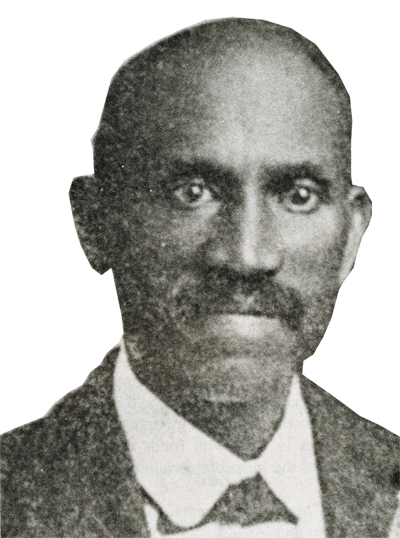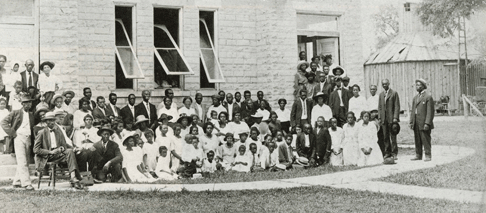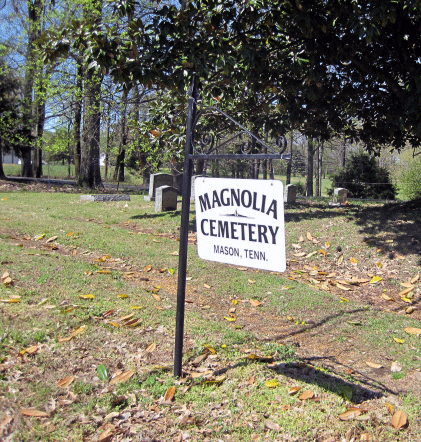
Family and early years
John W. Boyd was born about 1852 in Tipton County, Tennessee. (An 1871 Freedman’s Bank record listed his age as 19 and his birthplace as Covington.) His parents were Philip and Sophia Fields Boyd, who were slaves to Henry Sanford and his wife Jean Murray Feild [sic] Sanford (1830-1893). Henry Sanford's father was Col. Robert Walker Sanford (1802-1861), an early elected official of Tipton county, who had moved to Tennessee from Orange County, Virginia, bringing his slaves with him. Jean Feild Sanford's father was Charles Grandison Feild (1805-1845), of Mecklenburg County, Virginia, and Haywood County, Tennessee.
In the early 1850s Boyd’s mother, Sophia, transferred her membership from the Emmaus Presbyterian Church (under Pastor Peter Bland) to the Covington Presbyterian Church, where her three children were subsequently baptized: George Armistead, Judith Mariah, and John William, along with a grandson, Philip.
The death certificate of John’s brother Armistead Boyd stated that both his parents were born in Virginia. Sophia Fields Boyd’s obituary listed her birthplace specifically as Mecklenburg County, Virginia, which had been home to many of Mason's largest slaveholders – including the Feild family. Members of another influential slave-holding family in Mecklenburg County, the Boyds, were intimates and neighbors of the Feilds, both in Virginia and in Tennessee. It is likely that the Boyd name among the Feild slaves came from trading or intermarriage of slaves between the two families. Evidence has recently emerged indicating that John W. Boyd and Tennessee Representative William A. Feilds (44th General Assembly, 1885-1886) were cousins, perhaps even first cousins. Boyd is sometimes confused with a second John W. Boyd, who also lived in Tipton County. The two men were about the same age, but the latter John was the son of Jackson and Martha Boyd.
After Emancipation many of the African American members of the family changed the spelling of their name from Feild or Feilds to Fields. It is not clear whether they chose the standard spelling because it was less stressful (the children complained that their spelling of the name was constantly being corrected in school) or because it was a way to distance themselves from their former owners. The latter choice is less likely, since there is a considerable body of evidence indicating that these particular owners commanded great loyalty and respect from their slaves.
John Boyd was too young to take part in the Civil War, but toward the end of the war his older brother Armistead left the Sanford plantation and went to Memphis to join the Federal army. His war record states that he joined Company C of the 88th U.S. Colored Infantry on Jan. 21, 1865, at 19 years of age. He was mustered out a year later as a corporal. A story still extant in the community tells that, before his enlistment, after all the adult males had gone off to fight, Armistead, still a teenager, armed himself with a shotgun to protect his master's family.

(Image from TSLA)
Boyd passes the bar and becomes involved in local politics
In the early 1870s John W. Boyd lived in Mason (he referred to it as Mason Depot), boarding with a local family and working as a clerk for various local merchants, including grocer Robert Harrison (see 1870 census for District 10, Tipton County) and William A. McCloy, an early postmaster and mayor. At some point Boyd was admitted to the Covington Bar Association, and he made his living as a lawyer and/or a magistrate for the rest of his career. A magistrate in a rural county during those years was the equivalent of what we now think of as a “county commissioner.” He could issue warrants and hear minor criminal cases, perform marriages, and appoint guardians and administrators to help to settle estates. Magistrates were also part of the local legislative body that approved all county expenses and passed county laws and ordinances. In the 19th and early 20th centuries they were thought of as a “court” because of their judicial duties; in recent years, as county governments have assumed a more complex role, the magistrates/commissioners tend to be considered more of a legislative body.
J.W. Boyd was a delegate to the Republican State Convention in May 1876, and was selected as a delegate from Tennessee’s Ninth District to the National Convention in Cincinnati that nominated Governor Rutherford B. Hayes of Ohio for president.
Returning to Tennessee, Boyd was elected to his first six-year term on the county court in 1876, and re-elected in 1882 and 1888. In 1894 he either did not run or was defeated, but he returned to the court in 1897, evidently to finish out someone’s unexpired term, and was elected again on his own account in August 1900 for his final six-year term. Thus he served as a magistrate from 1876-1894 and from 1897-1906, well past the time when most African Americans were able to win election to county or municipal positions. His brother, George Armistead Boyd, was also elected to the court in 1882 from District 9, as was their cousin, Willis Lewis Fields, representing District 15. Both were also re-elected in 1888 (although Fields represented District 10 during this session); none of them won election to the court in 1894.
Marriage to Mattie Doggett and occupation
Boyd was married on March 13, 1879, to Martha C. "Mattie" Doggett in the Trinity Episcopal Church, Mason, Tennessee. Mattie was a member of St. Paul Episcopal Church, the local black Episcopal congregation, but the couple actually married in the white church, with their wedding ceremony conducted by its priest, Rev. C. F. Collins. Anecdotal references from surviving church members suggest that Boyd freely attended services in both churches, black and white.
While Mattie and her twin sister Nannie Doggett were Episcopalians, the Boyd brothers were originally Methodists, members of what survives today as Alexander's Chapel United Methodist Church. This church, too, was somewhat unusual in that it was not affiliated with either the Christian Methodist Episcopal (CME) or African Methodist Episcopal (AME) churches, the two major historically black Methodist denominations.
Mattie was the daughter of Andrew Doggett, a free man of color. Andrew was notable in that he owned property before the Civil War, acquiring 200 acres more after the war ended. John Boyd's brother Armistead married Nannie Doggett, Mattie’s sister. Neither couple left any surviving children, although the 1910 census indicated that Mattie, then 48, had given birth to one child. John and Armistead Boyds’ sister Judy married Henderson Stevens, a member of a respected family who owned land in Mason. Judy and Henderson Stevens did leave a number of descendants, one of whom provided much of the information we now know about the family.
Although no information has come to light concerning where or how John W. Boyd received his education or legal training, we do know that he was an attorney in the local courts and was widely respected among both the white and black communities. It is quite likely that the Boyd family had been permitted to obtain some rudimentary education even before emancipation. There is some evidence that for several generations this family of slaves had been high-achievers and had received special treatment from their masters. Perhaps this background gave them an advantage after emancipation and helped propel John Boyd into the legal profession. Despite the Jim Crow laws that disfranchised African Americans during the last decade of the 19th century and removed them from positions of power, Boyd was still representing District 10 as a magistrate on the county court as late as 1906, although by that time he was the only black member remaining on the court.
Election to the Tennessee General Assembly
John Boyd was elected to represent Tipton County for two terms in the Tennessee House of Representatives. In the 42nd General Assembly (1881-1882) he served on the committees for Immigration, New Counties and County Lines, and Tippling Houses. In the 43rd General Assembly (1883-1884) he was named to the committee on Federal Regulations. During his time in office, Boyd worked diligently with other African American legislators to overturn Chapter 130 of the Acts of 1875, the first Jim Crow law enacted in the South, permitting racial discrimination in public facilities. He also attempted to repeal the restrictive contract labor law, which had the effect of keeping working blacks in bondage. According to that law, “any laborer who broke a work contract or anyone who enticed a laborer away from a contracted job [was] subject to damages.” (Cartwright, 113-114) Two of Boyd’s bills were voted into law, one authorizing the governor to offer a reward for the arrest of a murderer, and one increasing the exemption from seizure or attachment in case of debt. The latter bill was intended to protect poor families from having to sacrifice all their resources to repay a financial obligation. A third bill, making it illegal for railroads to discriminate against any passenger paying first-class fare, was amended to require racial segregation of passengers and was then adopted. Appalled that his intentions had been so drastically distorted by the amendments, Boyd voted against his own bill, which was to become Tennessee’s second Jim Crow law.
Boyd’s campaign for the Senate

(Photo used by permission, Tipton County Historical Society)
In the election of November 4, 1884, having completed two terms in the House, John Boyd ran against Democratic attorney Houston Letcher Blackwell for an opportunity to represent Fayette and Tipton counties in the Tennessee Senate. (Blackwell, a Confederate veteran, was the former law partner of Democratic Congressman Charles Bryson Simonton of Covington, a member of the U.S. House from 1879-1883.) The State certified Blackwell as the victor, so when he died unexpectedly on January 2, 1885, three days before the 44th Session was to convene, Governor William B. Bate called for a new election on January 20. John P. Edmondson of Somerville took Blackwell’s place as the Democratic candidate against Republican Boyd. However, Boyd insisted that the second election was superfluous, since he was the rightful winner of the November election. Waiting in the Senate chamber from January 5 until the end of the month, he challenged the original election results, arguing that he had been defrauded of his seat and should be sworn in (Jno. W. Boyd v. Jno. P. Edmondson). According to Boyd, at some point during the November 4 election, the District 4 ballot box had mysteriously “disappeared,” along with at least 400 Republican ballots – more than enough to give Boyd the victory. In his effort to contest the election results, he took depositions from the sheriff and several election officials, whose testimony indicated that two of the Democratic election judges had indeed taken the box away with them when they went to supper, later claiming that it had been “stolen and carried off.” Despite such compelling evidence that the results of the original election were, in fact, invalid, the Senate nevertheless voted to seat Edmondson. A disappointed John Boyd, who would have been Tennessee’s first black Senator, returned to Tipton County. It would be 84 years (1969) before an African American would be seated in the Tennessee State Senate.
An odd little article in an the weekly Cleveland Gazette of July 17, 1897, said, “The mayor of Mason, Tennessee, is a colored man. His name is J. W. Boyd. It is said he is a very meritorious gentleman and will prove a general honor to his race.” Since 1897 was the year Boyd was reelected to his post as magistrate, perhaps the announcement of his new post was misconstrued.
Final years

John Boyd is buried in Magnolia Cemetery on Highway 59, Mason, Tennessee.
(Photo by John Marshall)
John and Mattie Boyd’s home for many years was in the town of Mason, just south of the railroad tracks on the east side of Main Street. John listed his profession as attorney in the 1910, 1920, and 1930 census records. He was the last African American to hold the post of magistrate for decades. John, who outlived Mattie, died on March 10, 1932, at about 80 years of age, and was buried in Magnolia Cemetery, Mason, Tennessee. The following is his obituary, found on the front page of the March 17, 1932, edition of the Covington (TN) Leader.
"WELL-KNOWN NEGRO BURIED AT MASON—John W. BOYD, a well-known negro of District #10, died suddenly of heart failure Thursday, March 10th. He was buried the following Sunday. There were no immediate survivors. Well up in the eighties in age, Boyd was politically prominent in the three decades following the Civil War. A resident of a district composed largely of negroes, he was for a number of years, magistrate for the 10th District, and following a split in the Democratic ranks in the years following 1880 was elected to the Legislature from this county. He was also a member of the Covington Bar."
Based on the research of John W. Marshall, Memphis, TN, author of The Early History of Mason (1985) and Mason: A Glimpse into the Past (1991). KBL 11/06/2012
Sources:
Alexander, James E. “The Roster of the Officers and Members of the House of Representatives. Forty-third General Assembly of the State of Tennessee, 1883-1884.” Tennessee State Library and Archives broadside collection.
Bailey, Russell. Historian.
Cartwright, Joseph H. The Triumph of Jim Crow: Tennessee Race Relations in the 1880s. Knoxville: University of Tennessee Press, 1976.
Covington Leader, March 17, 1932.
McBride, Robert M., and Dan M. Robinson. Biographical Directory, Tennessee General Assembly, Volume II (1861-1901). Nashville: Tennessee State Library and Archives, and Tennessee Historical Commission, 1979.
“Sweeping Victories. At Home and Abroad the Story is the Same,” Arkansas Gazette, November 8, 1882.
Tennessee General Assembly. Journal of the House of Representatives of the State of Tennessee. Nashville: Tavel and Howell, 1881, 1883.
